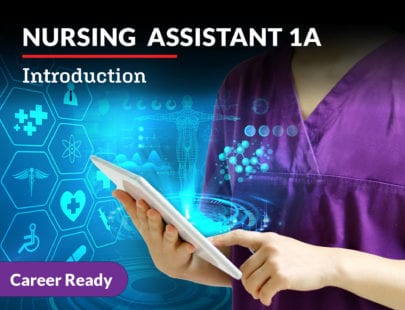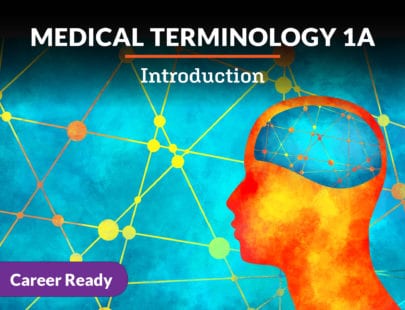
Nursing Assistant 1b: Patient Care
As a Nursing Assistant, you are heavily involved in the care of your patients. But what does a typical day look like? How do you care for your patients during your shift? From hospital settings to home health care, from pre- and postoperative to rehabilitation. Discover how best to communicate and work with your team to ensure a safe environment, prevent and control infectious diseases, advocate for your patient’s rights, and provide appropriate care – even for the most complex patient needs.
Units at a Glance
Unit 1: Health Care: How It Operates
You have decided that a career in health care is a good idea—and you’re right! Health care is an exciting, dynamic field with many types of job opportunities and employment. Healthcare employers ensure quality of care for patients, in addition to operating as businesses. This means that facilities have financial, environmental, community, and marketing interests. Think about how many different people with all types of expertise come together to make a community hospital work – and you can be a part of it! As a nursing assistant, you will be closest to the patient and a valuable resource for your employer.
What will you learn in this unit?
- Differentiate types of healthcare systems in the United States
- Define institutional structures, policies, procedures, rules, and the role of human resources
- Identify roles, responsibilities, and relationships in a healthcare organization
- Explain the role of the nursing assistant in a variety of settings
Unit 2: Patient Rights
You have the right to …
We all have rights in our day-to-day lives, as customers, as human beings, and as citizens. Patients also have rights when they are in a healthcare institution. They have rights that protect them, keep them safe, and allow them to make independent decisions. Nursing assistants need to understand these rights and advocate for their patients to protect their rights. Some patient rights are associated with being able to choose their own care, some are concerned with privacy, and others help protect patients from harm while in a healthcare facility. Respecting the rights of patients is an important part of the job of any healthcare professional.
What will you learn in this unit?
- Describe the types of rights patients have and explain how to support and uphold patient rights
- List regulations and methods of oversight of patient rights in health care
- Explain the role of the nursing assistant in handling patient complaints and grievances
- Discuss and differentiate various legal concerns for nursing assistants related to the rights of the patient
Unit 3: Patient Safety
Why is patient safety such an important topic? Aren’t hospitals and other types of healthcare facilities safe places? You might be surprised to learn that injuries and accidents occur on a daily basis in healthcare facilities. In fact, in some instances, a patient is less safe in a hospital than they are in their own home. But you, as a nursing assistant, can help reduce the risk of injury or accident for your patients. Here, we will introduce you to safety concepts and actions you can take to ensure the safety of your patients.
What will you learn in this unit?
- Explain why medical errors occur
- Describe the process of discovering and reporting medical errors
- Identify types of non-medical emergencies that occur in the healthcare setting and actions you should take when they occur
- Discuss rounding and other safety actions that can be taken to reduce the possibility of patient injury
- Define testing and calibration and explain the goals of preventive maintenance
Unit 4: Infection Control and Prevention
On December 31, 2019, health authorities in China alerted the World Health Organization of a mysterious illness that was spreading in the Chinese province of Wuhan. The cause of the illness was not known, and at least 44 people were experiencing respiratory symptoms such as cough and difficulty breathing. By January 2020, when the first case was identified in the United States, the entire province of Wuhan had shut down businesses, public transportation, and schools. In March 2020, the World Health Organization declared the disease called COVID-19 a pandemic, a widespread or worldwide outbreak of a contagious illness. All too quickly, millions of people became infected, disrupting lives across the globe. You may have wondered how this disease could have spread so quickly and changed our lives so dramatically? You’ve come to the right place – nursing assistants should understand what causes disease and infection and how it spreads. But most importantly, they should understand how to prevent infection from spreading in a healthcare setting.
What will you learn in this unit?
- Identify different types of pathogens and explain how they cause disease
- Define the components of standard precautions, and discuss how standard precautions are used to prevent the spread of infection
- List types of transmission-based precautions and how to apply each type appropriately
- Differentiate cleaning, disinfection, and sterilization and discuss how and when each is performed
- Describe sterile techniques and how to set up a sterile field and apply sterile gloves
Unit 5: Patient Care I
You have learned about many aspects of working in health care, from looking for a job to communication skills to preventing the spread of infection. But what about actually your everyday duties as a nursing assistant? What will you do with your patients during your shift? How will you work with the rest of your team to ensure a safe environment, appropriate care, and comfort measures for your patient? Here, you will learn about assisting patients when they are first admitted, prioritizing care, and measuring and monitoring vital signs. You will also learn about prevention of skin breakdown and complications of limited mobility. In addition, you will be introduced to certain types of medications patients take and what effect they have on the patient. Ready? Let’s take your skills to the next level!
What will you learn in this unit?
- Describe the role of the nursing assistant in setting up the patient environment and prioritizing care within that environment
- Define vital signs, list normal parameters, and explain how vital signs are obtained and used in patient care
- Explain complications of immobility and how a nursing assistant provides care to prevent these complications
- Discuss the effects of certain drugs on the body and describe precautions the nursing assistant must take when a patient is taking certain drugs
Unit 6: Patient Care II
Patients often have complex needs. They may need to have the volume of fluid they take in or put out precisely measured, or they may need to provide specimens for testing. Some patients require specialized tests to evaluate heart function or need blood or urine testing. As a Nursing Assistant, you may be asked to take care of a patient who is fed through a tube, has had surgery with drainage tubes in place, or even a patient who is dying. Together, we’ll discover how to provide care to complex patients, calling on you to apply many of the skills you already know, and giving you the opportunity to learn new ones.
What will you learn in this unit?
- Discuss fluid balance in patients and methods for measuring intake and output
- Demonstrate correct procedure for collecting, labeling, and transporting various specimens for laboratory testing
- Explain electrocardiography and how to perform bedside heart monitoring, including identification of common abnormal heart rhythms
- Describe complex patient care situations, including drainage tubes, nutritional support, and terminal illness, including post-mortem care
Unit 7: Skills Related to the Hospital and Home Health Settings
You have learned about the different tasks you will perform as a nursing assistant and are likely eager to build on your knowledge. But, have you considered where you might want to work as a nursing assistant? Here, we will take a closer look at skills needed to work at two common job settings: the hospital and the home. Knowing what to expect and how to use the necessary equipment, as well as understanding the unique type of care required in each setting will help you develop a clearer picture of the type of work you will perform and better insight into what you would like to do.
What will you learn in this unit?
- Describe and demonstrate proper use of hospital equipment, including equipment used in patient transfers
- Assist with positioning and draping patients during medical examinations or procedures
- Discuss preoperative and postoperative patient care
- Explain home healthcare duties and considerations for nursing assistants
Unit 8: A Holistic Approach to Rehabilitative and Restorative Care
Illness and injury can have a profound effect on how a person perceives themselves and the world around them. A person who was a high-functioning, independent professional may suddenly become dependent on others for the most basic of functions. This can be psychologically devastating to the patient. Rehabilitation takes time and patience and does not always ensure a complete return to previous levels of function. A patient may have to accept small signs of progress and celebrate minor gains. A nursing assistant can help a patient set and meet goals, realizing that even small accomplishments can be meaningful in a journey to regain independent function.
What will you learn in this unit?
- Explain the hierarchy of basic human needs and how a nursing assistant works to meet them
- Discuss the holistic approach to rehabilitation and how the rehabilitation program is designed to support the entire person
- Describe how to respect individual preferences in a long-term care environment and maintain sensitivity to mental health and psychosocial aspects of long-term care
- Define adaptive behaviors and coping mechanisms and identify how specific coping mechanisms may be manifested in long-term care
- Differentiate rehabilitation and restorative care and describe how restorative care compliments the rehabilitation process
Required Materials
Physical
- Video recording device
- Various healthcare props to demonstrate tasks (gown, mask, gloves, equipment, bed, sheet, disinfectants, watch, thermometer, scale, tape measure, etc.)
- Mode of communication (cell phone, video conferencing program, etc.)
- Calculator
- A sink
- Audio recording device
Software
- Spreadsheet software
- Word processing software
- Presentation software
- Graphic design software (optional)
Other
- A “patient” (This can be a stuffed animal, a doll, or a friend/family member.)
Optional
- Camera
- Posterboard with markers



